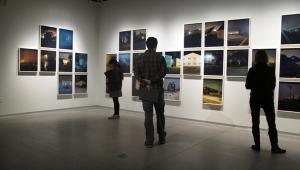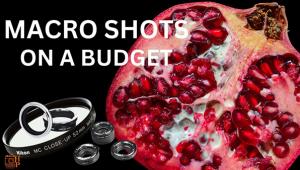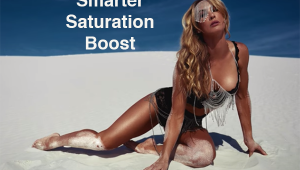Fine Art Photography: Striking A Balance
Everywhere you turn—from assignments, self-assignments and from personal work—you can create opportunities for fine art images. Creating fine art photography can add a revenue stream to your commercial photography business. While the goal of selling images as fine art might be seen as unreachable, in fact the marketing and self-promotion methods and techniques for commercial work and fine art are very similar.

What defines a work as art? This is a highly subjective question. As the artist, you begin to answer it by presenting a strong and consistent message that identifies your work in a unique way. Look at it from the point of view of fine art clients. They will always want to verbalize or describe the visuals they want to buy as art so you are best served by looking through their eyes. Defining your fine art by style or subject can be done by describing it using terms such as: contemporary art, conceptual art, traditional landscape, urban landscape, nature photography, documentary photography, and the photography of people, just to name a few.
Even these terms break down into subsets. For example, the photography of people can be images of children at play or nature photography can be images of old-growth forests. Photography can usually be defined as “fine art” by style or subjects you are passionate about. It is your job to find your passion and to find the words that will help the fine art client visualize your work and begin to relate to you through your work.
Who buys photos as art? There are many different kinds of fine art photography clients and places in which they buy work. There can be the more traditional markets such as galleries, art dealers, art fairs, and photo festivals. Buyers can be individual collectors; corporate fine art buyers; corporate art consultants; stock agencies; publishers of greeting cards, calendars, and poster art; book publishers; and interior designers. They can even be institutions such as museums or associations such as nonprofits.

To get an inside look at the fine art photo market we talked with two professionals in the fine art field—a fine art photographer and a fine art gallery owner.
Sheila Pree Bright of www.sheilapreebright.com is an Atlanta-based photographer who challenges perceptions of identity with portrayals of urban and suburban themes, as well as provocative commentary about American beauty standards. She received national attention after winning the Santa Fe Prize from the Santa Fe Center for Photography in 2006 for a series of work entitled “The Suburbia Series.” Recently, Bright embarked on one of her most ambitious projects to date called “Young Americans,” which was underwritten by a grant from the Aetna Foundation.
Susan Spiritus of susanspiritusgallery.com has been a leader in the field of fine art photography for 35 years, handling the work of over 50 artists, including photographic luminaries, popular contemporary artists, and emerging talent. Today, the gallery’s inventory includes the work of artists such as Ansel Adams, Ruth Bernhard, Manuel Alvarez Bravo, Eikoh Hosoe, and George Tice. Her gallery works with private collectors, corporations, and design professionals.

Shutterbug: What has been your experience in establishing yourself in the fine art world?
Sheila Pree Bright: While attending school for my MFA at Georgia State University, I was awarded the National Bronica Award and the En Foco New Works Photography Award, and a Fellow at the National Graduate Seminar at The International Photography Institute. As a result, I think attending school along with entering competitions and winning awards is important. Focusing on producing work I felt strongly about was also a start for branding my work and name.
In 2006, I received national recognition by winning the Center Prize (formally known as the Santa Fe Prize) for the series “Suburbia” (www.blurb.com/bookstore/detail/1212678). This award was nomination only but since then my career has been nonstop with exhibitions and funding by way of curators who have been watching my career since the Center Prize award.
In 2008, the “Young Americans” series, a traveling show until 2010, premiered at the High Museum of Art in Atlanta; the “Suburbia” series opened at FotoFest 2010 Biennial in Houston and the Museum of Contemporary Art in Cleveland; “Girls, Grillz and Dolls” at the Kentucky Museum of Art and Craft and Power House in Memphis. In 2009, CNN Live came to interview me for the “Young Americans.” Most recently I have received calls from advertising agencies based on the interview with CNN.
Museums and curators have played an important part in the development of my fine art career. Collectors of my work such as the High Museum of Art, Museum of Contemporary Art, Wadsworth Atheneum Museum of Art, Nerman Museum of Contemporary Art, Library of Congress, and the Paul Jones Collection have been supporters of my work along with solo and group exhibitions.
I believe you can research galleries and museums and send submissions of your work to get established. But I think the key to being successful in the fine art market is to build personal relationships with curators, publishers, collectors, and photo editors, because people need to get to know you as a person as well as get to know your work.

Susan Spiritus: It was easy to establish myself in the fine art world, because when I opened my gallery, there weren’t many in existence! That’s not saying that there weren’t many fine art galleries, but I chose to open and specialize in fine art contemporary photography. If my memory is correct, there were less than one dozen galleries in this area, nationwide.
I opened the doors in 1976 to the Susan Spiritus Gallery in Newport Beach, California, so I could share my passion for photography and for collecting art with others. Today, in addition to handling the work of some of the top names in photography, I also represent many contemporary artists, including California-based Roman Loranc, Susan Burnstine, Jeffrey Becom, and Hiroshi Watanabe as well as others from across the country, including George Tice, Cara Barer, Christopher Burkett, and Camille Seaman. In addition, I represent several photographers from Japan, Sweden, and France. I also make it a point to indentify and cultivate the careers of many mid-career and emerging artists. In today’s market, my clients range from private collectors, other galleries, corporations, space planners, architects, interior designers, and consultants.
SB: What has been the most effective way to market fine art work?
Susan Spiritus: The Internet plays an important role for the gallery and a website works well at the beginning. Our website was recently updated to include new features showing a selection of our corporate installations and the new gift selection page which also offers gift certificates. I now use Facebook and Twitter quite extensively and have a Susan Spiritus Gallery Newsletter e-mailed out to my list on a monthly basis. Also, the gallery has participated in numerous art fairs, including photo l.a. 2011 and San Francisco Fine Art Fair 2011.
Entering awards programs is a good way to promote your work. I oftentimes serve as a reviewer for these programs—Photolucida, the Lucie Awards, and other photography organizations. I also do the in-person reviews when invited and have done Review Santa Fe, Palm Springs Photo Festival, PhotoNOLA, Review LA amongst others.
But for me, I deliver personal and highly individual customer service first and foremost to all of my clients. I will make presentations of artwork in their home or office; I will recommend where artwork should be hung and hang it, and I offer a complete and archival framing service.
Sheila Pree Bright: The best way in the 21st century to market to fine art clients is to research and attend as many portfolio reviews as possible and to research and enter photography contests. This will expose your work to curators, galleries, publishers, photo editors, and collectors who can see your work and become familiar with you. Of course, a website plays a very important role in marketing because the industry can view your changing work very quickly. Social networking such as Facebook, Twitter, and Flickr is the new movement for branding yourself and your work.
SB: What advice would you give to aspiring artists who dream of being represented by a successful gallery?
Susan Spiritus: My advice has always been the same. Continue to make your work and make the work that is important to you, the artist. In addition, I would insist that the work be your vision, with your personal mark of creativity. Don’t feel the necessity to make work that you hope will please others. I have had photographers ask me, “What type of work do you want?” And, “What sells?” I do not want an artist to make what I want, I will not reply to that inquiry. Once you have a complete body of work that you are comfortable with, you can then begin your quest to find a gallery space that is suitable for your work.
Are You Ready?
The visual diversity of fine art photography sold today, from the completely unique to the everyday image created in an extraordinary way, gives you many opportunities. Clients such as museums and galleries are looking for images that have strong interest and appeal to their clients. And then there are art consultants who specialize in serving specific collectors, for example, someone who only collects images of white picket fences, urban landscapes, or the beach. That is the beauty of fine art; it could be of any subject or style. You are ready when you have a subject you are passionate about. You are ready when you have images you think appeal to a wide range of possible customers. You are ready when you have done your research and homework!
Partial List Of Resources For Selling Fine Art PhotographyBooks
• The Artist’s Way by Julia Cameron
• Art Marketing Handbook by Calvin J. Goodman
• Selling Art Without Galleries: Toward Making a Living from Your Art by Daniel Grant
• The Artist’s Guide to New Markets: Opportunities to Show and Sell Art Beyond Galleries by Peggy Hadden
Websites
• www.artmarketing.com
• www.artscuttlebutt.com
• www.artbusiness.com
• www.theartlist.com
• www.wetcanvas.com
- Log in or register to post comments
















































